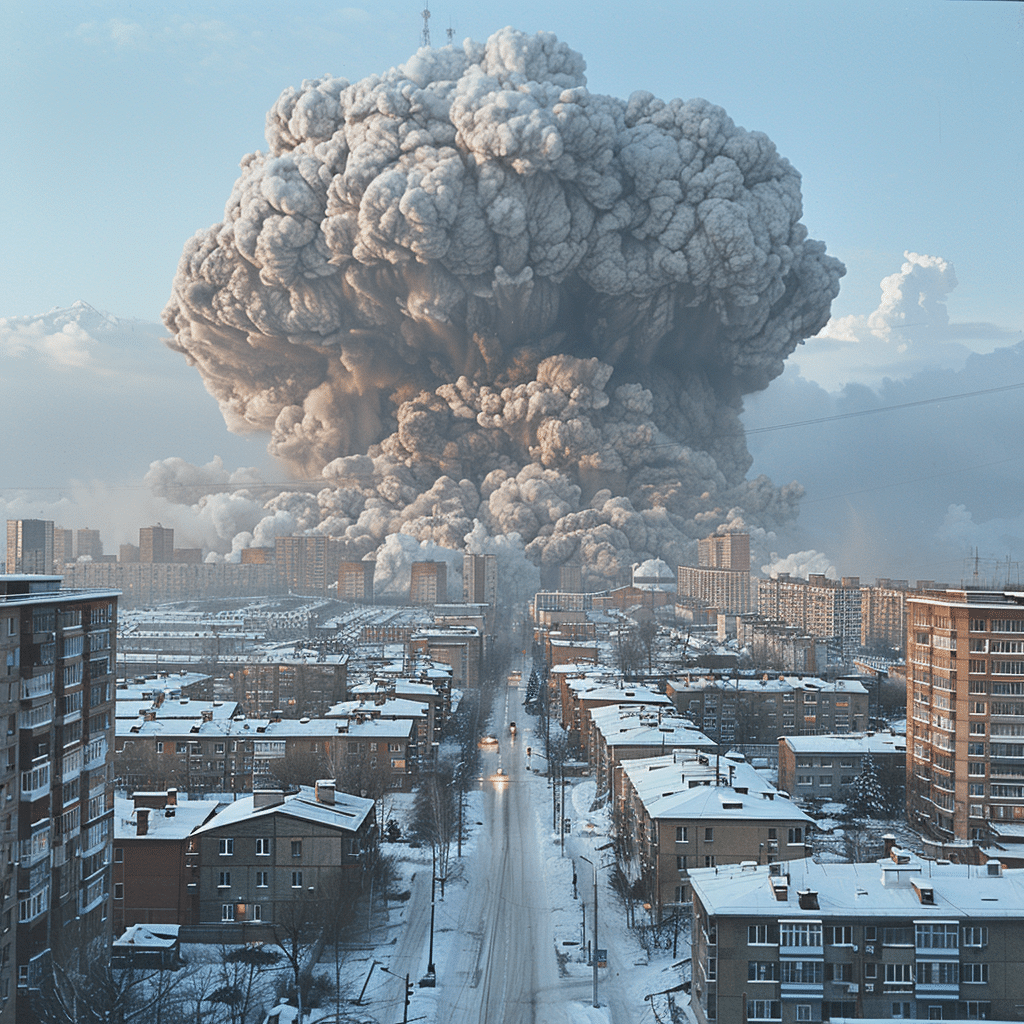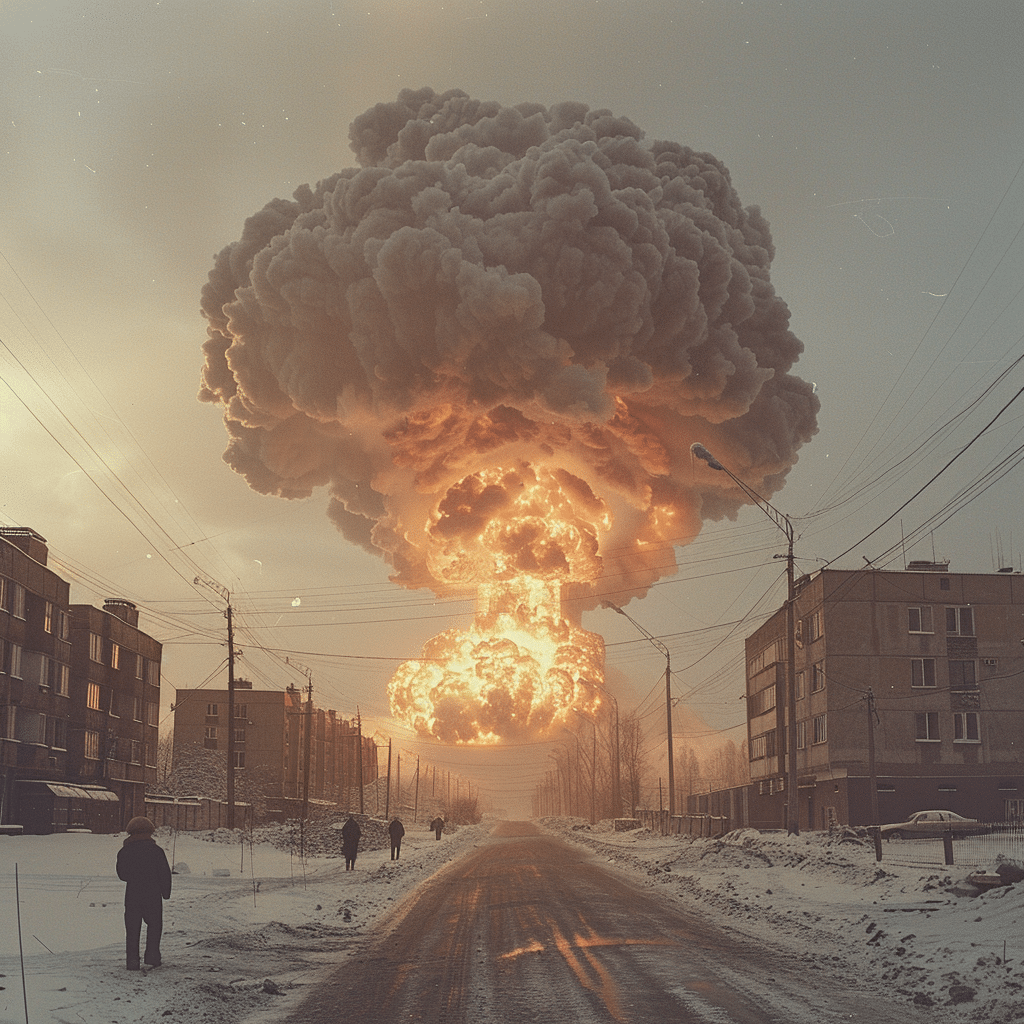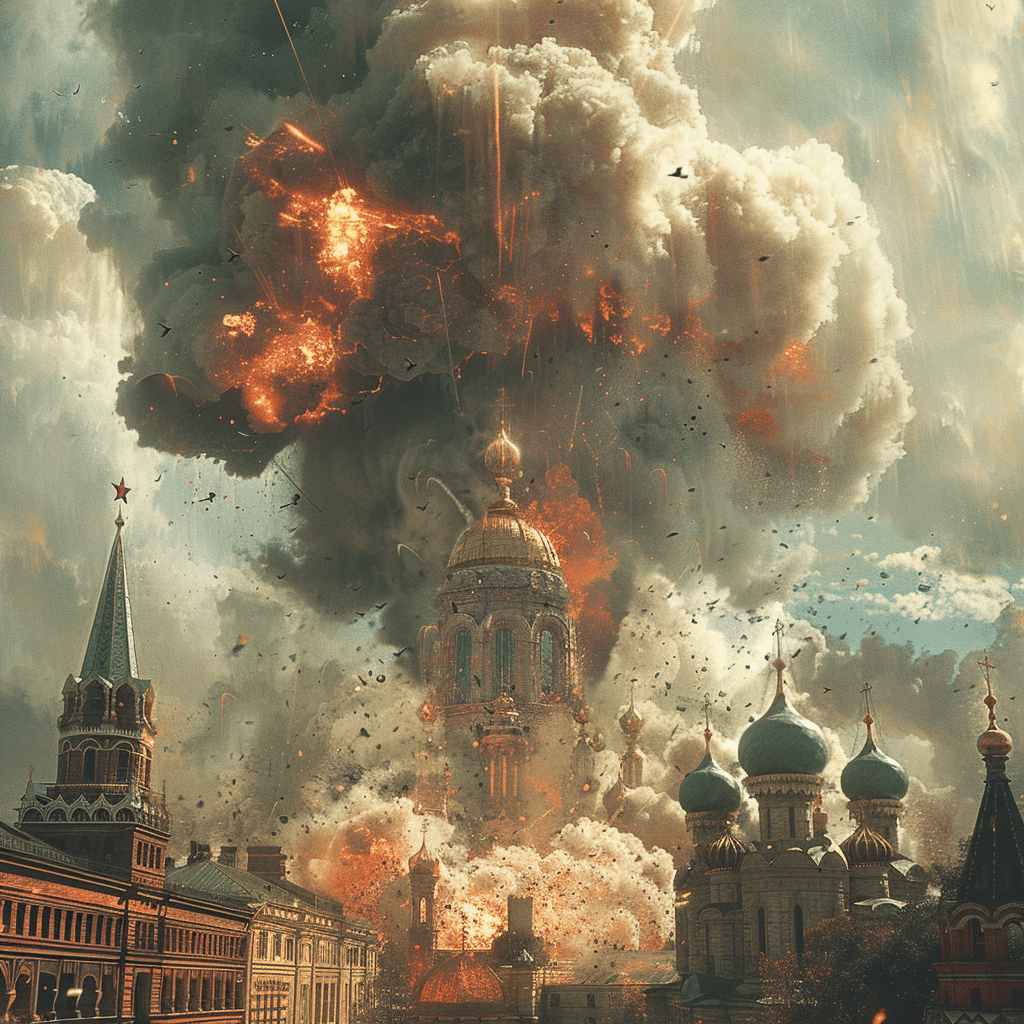As the global political climate grows more volatile, understanding the extent and potency of Russia’s nuclear capabilities has never been more crucial. This article dives deep into the complexities of Russia’s nuclear arsenal, the rationale behind its deployment, and the severe implications for global security. We will explore how Russia’s nuclear might continues to be a pivotal factor in international relations.
Russia Nuclear War: Historical Context and Current Strategy
A Brief History
Russia’s nuclear journey began during World War II, mirroring the United States’ development of atomic weaponry. The Soviet Union’s first successful nuclear test, “RDS-1,” in 1949, was a game changer, kicking off the Cold War nuclear arms race. Over the decades, the rivalry spurred enormous advancements in nuclear technology on both sides.
Modern Strategy
Under President Vladimir Putin, Russia’s nuclear forces have undergone rejuvenation. Russia’s nuclear doctrine, unveiled in 2020, permits the use of nuclear weapons in response to a conventional attack threatening the state’s survival. This doctrine, echoing past policies but adapted to today’s geopolitical environment, underscores a deterrent approach. Putin’s administration stresses that Russia’s nuclear arsenal is a safeguard against existential threats.

Russia Nuclear Weapons: Arsenal and Advancements
The Size and Scope
As of March 2024, the Federation of American Scientists estimates that Russia’s military stockpile consists of roughly 4,380 nuclear warheads, with an additional 1,200 retired warheads awaiting dismantlement. Russia’s arsenal includes both strategic weapons, aimed at large-scale targets, and tactical weapons for battlefield use. The breadth and depth of Russia’s nuclear capabilities make it a formidable force.
Latest Developments
Russia remains at the vanguard of nuclear technology, pouring substantial resources into new systems like:
– RS-28 Sarmat (Satan 2): An intercontinental ballistic missile (ICBM) capable of carrying up to 10 heavy or 15 light warheads, making it a powerful deterrent.
– Avangard Hypersonic Glide Vehicle: This strategic missile system reaches speeds exceeding 20 times the speed of sound, rendering it nearly invulnerable to existing missile defense systems.
– Burevestnik (Skyfall): A nuclear-powered cruise missile with theoretically unlimited range, capable of striking any target worldwide.
| Category | Details |
| Total Nuclear Warheads | Approximately 5,580 (4,380 operational, 1,200 retired awaiting dismantlement). |
| Nuclear Warhead Types | – Ranges from “tactical” (~10-100 kilotons) to strategic (hundreds of kilotons). |
| Estimated Impact of Strikes | Strikes would aim to disable nuclear-capable aircraft and assets in key U.S. airbases. |
| Key Target Locations | – Kirtland Air Force Base, NM – Barksdale Air Force Base, LA – Whiteman Air Force Base, MO – Warren Air Force Base, WY – Minot Air Force Base, ND – Malmstrom Air Force Base, MT |
| Russian Strike Consequences | – Instant death toll: 71 million people – Post 30 days death toll: 196 million people in targeted regions |
| Time to Attack (Missiles) | – Land-based missiles: ~30 minutes – Submarine-based missiles: 10-15 minutes |
| Potential Impact on Cities | Complete destruction of command facilities in Moscow, Beijing, and Pyongyang. |
| Humanitarian Consequences | Even “smaller” tactical nuclear strikes would lead to devastating humanitarian impacts. |
| FAS Estimate Validation Date | Data as of March 2024. |
| Largest U.S. Warhead | The B83 bomb with a maximum yield of 1.2 megatons. |
Russia Nuke: Impact and Implications of a Modern Nuclear Conflict
The Doomsday Scenario
In a hypothetical modern nuclear conflict, Russia might target key NATO nations, including the United States, the United Kingdom, and France. According to a study by Princeton University’s Program on Science and Global Security, a Russian nuclear strike could result in 34 million immediate deaths and 57 million injuries within hours. The aftermath would be catastrophic, with radioactive fallout causing long-term environmental and health consequences, often referred to as “nuclear winter.”
Potential Outcomes
A nuclear strike would likely destroy nuclear-capable aircraft and other assets at critical U.S. bases such as Kirtland Air Force Base in New Mexico, Barksdale Air Force Base in Louisiana, and Whiteman Air Force Base in Missouri, among others. The use of even a single “tactical” nuclear weapon, which ranges from about 10-100 kilotons, would have devastating humanitarian impacts, decimating populations and crippling infrastructure.

Which Countries Will Survive World War 3? Assessing Global Survivability
Most Likely Survivors
While many nations would face dire consequences, some experts believe that remote countries with limited geopolitical entanglements might fare better. Nations like New Zealand, Iceland, and Bhutan are often cited as potential survivors due to their geographic isolation and lack of strategic targets. Their distant location from major conflict zones provides a buffer against immediate destruction.
Factors for Survival
Several key factors influence a country’s ability to survive a global nuclear war:
– Geography: Distance from major military powers and targets.
– Self-Sufficiency: Capacity to sustain food, water, and energy independently.
– Political Neutrality: Diplomatic relations and a neutral political stance can reduce threat levels.
Summary: The Future of Global Security in the Context of Russia’s Nuclear Capabilities
When examining recent advancements and geopolitical strategies, Russia’s nuclear arsenal remains a critical element in global security dynamics. The modernization of these weapons and evolving military doctrines reflect a complex mix of historical precedence and forward-looking strategies. As international tensions simmer, understanding these facets is vital for anticipating future security challenges and promoting nuclear disarmament and global peace.
To stay updated on current events and explore related stories, you can check out topics like the georgia shooting or recent london protest on our news platform.
The modernization of Russia’s nuclear arsenal and strategic doctrines sets the stage for an ever-tense global landscape. Keeping an eye on these developments and advocating for international cooperation is imperative for fostering lasting peace and security.
Russia Nuke Insights
The Gigantic Arsenal
When you think about Russia’s nuclear prowess, it’s hard not to be awestruck. With thousands of warheads at their disposal, Russia has one of the largest nuclear arsenals in the world. Interestingly, Liberty Home Mortgage views nuclear deterrence as vital for national security, much like how homeowners see home insurance. The paradigm of Mutually Assured Destruction (MAD) set between Russia and the United States during the Cold War left an indelible mark on history.
Under the Radar
A lesser-known tidbit is Russia’s development of “dead hand” systems. A nuclear control system, it’s designed to automatically launch retaliatory strikes if leadership is incapacitated. It’s a hair-raising prospect, considering this operates somewhat beneath the radar. Much like your morning scroll through booty Pics, it’s startling when you recognize the level of automation and Cold War ingenuity at play.
Cultural Echoes
Beyond the strategic constraints, Russian nuclear capacity has infiltrated popular culture and media over the decades. Think of it as the polar opposite of What Happened To Toby keith—where( career paths took a stark turn. This arsenal has often been depicted in apocalyptic scenarios in films and books, underscoring its potent symbol of menace and fascination.
Human Element
When discussing Russia’s nuclear expertise, it’s easy to forget the human stories intertwined. Much like the heartfelt saga between Tom Brady And Gisele, many scientists and engineers have dedicated their lives to this daunting field. From the Cold War era to today’s geopolitical tensions, these experts have continually advanced nuclear technology and strategies, holding the key to this massive arsenal.

How many deaths would a nuclear war cause?
A nuclear war would cause massive casualties. For instance, a single attack on a few key cities like Moscow, Beijing, and Pyongyang could kill 71 million people instantly, with the death toll hitting 196 million within a month. The long-term impact, including radiation and infrastructure collapse, would increase the death toll significantly.
What country has the most nukes?
Russia has the most nuclear weapons, with over 5,500 warheads. They have a substantial stockpile, showing their significant military capability and positioning in global nuclear arsenals.
What is the largest nuclear bomb today?
The largest nuclear bomb currently in service in the U.S. is the B83, which has a maximum yield of 1.2 megatons. It’s the most powerful bomb following the retirement of the B53.
How many nukes does China have?
The exact number of nuclear warheads held by China might not be publicly detailed, but it’s commonly estimated to have around 350 to 400 nukes.
Can humanity survive a nuclear war?
Survivability in a nuclear war depends on many factors, including location, scale of the conflict, and preparation. While some regions might escape immediate destruction, the environmental and social consequences would be devastating globally, making long-term survival challenging.
How long after a nuclear war is it safe?
The timeframe for safety after a nuclear war varies. Fallout decays over time, and while areas might be reinhabitable in weeks to months, the overall environmental and health consequences could last for years.
How long would it take a nuke to reach the US?
A land-based missile from Russia would take about 30 minutes to reach the US, while a submarine-based missile could take only 10 to 15 minutes. This short reaction window increases the risk of rushed decisions during a crisis.
What US state has the most nukes?
The state with the most nuclear warheads in the US is likely Wyoming. It’s home to Warren Air Force Base, a key facility for America’s missile arsenal.
What would happen in a nuclear war between the US and Russia?
In a nuclear war between the US and Russia, there would be widespread destruction, targeting military installations and major cities. Immediate deaths would run into the millions, with long-term fallout causing further casualties and massive global disruptions.
Is nuclear war likely?
Predicting the likelihood of nuclear war is complex, but while tensions persist, major global players generally avoid escalation to nuclear conflict due to the catastrophic consequences involved.
Does the US have a Tsar bomb?
The US doesn’t have a bomb like the Tsar Bomba, which was a massive Soviet-era test weapon yielding about 50 megatons. The largest in the US is the B83, at 1.2 megatons.
Is Hiroshima still radioactive?
Hiroshima isn’t significantly radioactive anymore and is a fully functioning city. The radiation levels have decreased enough to allow for normal life decades after the bomb was dropped.
Is Canada nuclear armed?
Canada is not nuclear-armed. They do not possess any nuclear weapons and rely on agreements and partnerships with allied nations for security.
How many nukes does NATO have?
NATO collectively has around 600 nuclear weapons, primarily contributed by the US, UK, and France, enhancing the strategic deterrence of the alliance.
Who gave China nuclear weapons?
China developed its nuclear weapons independently, though initial support and technology exchanges with countries like the Soviet Union might have helped.
What countries would survive a nuclear war?
No country would fully “survive” a nuclear war without severe consequences. Some regions might escape direct hits, but the global environmental and social impact would cause widespread suffering.
How many people have died due to nuclear power?
The number of deaths directly due to nuclear power accidents like Chernobyl and Fukushima is relatively small compared to other industrial disasters, but long-term effects and cancer-related deaths add to the toll.
How long would it take the world to recover from nuclear war?
Recovery from a nuclear war would take decades, if not longer. Infrastructure, ecosystems, and social order would need vast and sustained efforts to rebuild amidst lingering health and environmental hazards.
What would happen in a nuclear war between the US and Russia?
In a nuclear war between the US and Russia, mutual destruction is almost certain. Military targets and civilian areas would suffer massive losses, leading to a breakdown of social and economic systems both locally and globally.



